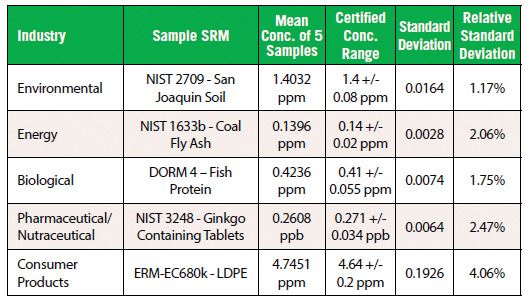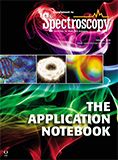Determination of Mercury in Mixed Matrices
Application Notebook
Commercial testing laboratories often come across a wide mix of sample types for trace metal analysis. One of the key elements that these labs need to quantify is mercury. Traditionally, analytical chemists have had to rely on techniques like CVAA and ICP-MS for mercury determination that involve a time consuming and a labor-intensive sample preparation step. Direct mercury analysis, as described by EPA 7473, is an alternative method to traditional techniques that enables a chemist to run mixed matrices without the need for digesting them and yields results in as little as ~5 min per sample. This makes it significantly faster and cost effective with comparable or better recoveries than CVAA and ICP-MS.
With the influx of many local and international regulations aimed to minimize environmental and consumer exposure to heavy metals in the recent past, consumer testing laboratories that offer services for trace metals analysis have realized a variety of potential growth opportunities. However, associated with these opportunities is the challenge that these contract laboratories must remain cost-competitive while addressing increased throughput demands and developing methods to successfully prepare and analyze a wide variety of sample matrices.
With the influx of many local and international regulations aimed to minimize environmental and consumer exposure to heavy metals in the recent past, consumer testing laboratories that offer services for trace metals analysis have realized a variety of potential growth opportunities. However, associated with these opportunities is the challenge that these contract laboratories must remain cost-competitive while addressing increased throughput demands and developing methods to successfully prepare and analyze a wide variety of sample matrices.

Traditional techniques used to analyze mercury involve a sample digestion step, after which they are analyzed on CVAA or ICP-MS. Although effective, sample preparation requires manpower, equipment, handling and disposing large amounts of acid that not only takes hours for completion, but also is very expensive. Alternatively, the U.S. EPA developed a method 7473 for rapid determination of mercury in solids and aqueous samples without sample prep. This method uses an integrated sequence of thermal decomposition followed by catalytic conversion, amalgamation, and atomic absorption spectrophotometry.
Instrumentation
A direct mercury analyzer (DMA-80 Tri-Cell) from Milestone Inc., was used for this experiment. The instrument was configured to sequentially process up to 40 samples placed on the auto-sampler. The auto-sampler automatically aligned and accommodated quartz (1500 µL) and nickel (500 mg) sample boats. All the components of the DMA-80 instrument were contained in a closed system to ensure that the samples were not exposed to outside interferences. Oxygen is used as a carrier gas at 65 psi pressure and a flow rate of 7 L/h.
Calibration
The DMA can be calibrated using aqueous standards or standard reference materials (SRM). The DMA-80 used for this experiment had a tri-cell spectrophotometer and covered a dynamic range of 0.0015–1500 ng Hg. Each cell was calibrated using different volumes of 1 ppm and 0.1 ppm stock solutions, prepared from an NIST traceable 1000 ppm Hg standard solution (VHG Labs).
To test the efficiency of the DMA-80, five standard reference materials (SRM) from five different industries were run sequentially on the DMA-80, with each industry standard reference run in triplicate. Sample mean concentrations, standard and relative standard deviations were calculated and compared to the certified mercury values of the standard reference material.
The concentrations shown above for a wide variety of standard reference materials were not only in the certified range of mercury concentration but also had very low RSD's, indicating the high accuracy and reproducibility of the DMA-80. Furthermore, testing a sequence of different matrices with concentrations ranging from low ppb to ppm also showed that there was no carryover of mercury from sample to sample.
Commercial testing laboratories are required to analyze different matrices accurately and quickly, while keeping operating costs under control. The DMA-80 is an excellent productivity tool providing results in ~5 min/sample and proves to be proficient, matrix-independent, and cost effective, while eliminating the challenges of sample preparation posed by conventional mercury analysis techniques.

Milestone Inc.
25 Controls Drive, Shelton, CT 06484
tel. (203) 925-4240, toll free (866) 995-5100, fax (203) 925-4241
Website: www.milestonesci.com

New Study Reveals Insights into Phenol’s Behavior in Ice
April 16th 2025A new study published in Spectrochimica Acta Part A by Dominik Heger and colleagues at Masaryk University reveals that phenol's photophysical properties change significantly when frozen, potentially enabling its breakdown by sunlight in icy environments.